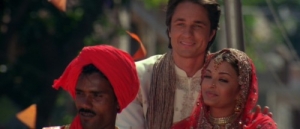Bride and Prejudice
Year of release: 2004
Directed by: Gurinder Chadha
United Kingdom, United States
Shots of an aeroplane in the opening sequence mark the arrival of the UK-based NRI Balraj and his American friend Darcy, two single men in possession of a good fortune and in want of a wife, to Armitsar. Like Austen’s Mr and Mrs Bennet, Chadha’s Mr and Mrs Bakshi are looking for eligible suitors for their four daughters, Jaya, Lalita, Maya and Lakhi. An Indian wedding (the first of a total of four featured in the film) provides the social setting where Lalita and Darcy, Jaya and Balraj first meet. In keeping with the source novel and the generic conventions of the romantic comedy, the paths of their courtships are rocky. However, it is not the parents’ objection to the inter-ethnic romance the couple has to overcome. Admittedly, Darcy has to be educated in all things Indian – be it dancing, drumming or even keeping his Indian-style trousers from falling down – to recognise that his ethnic snobbery and arrogance vis à vis ‘Hicksville, India’, as he derogatively calls Amritsar, are out of place before he is worthy of the beautiful bride Lalita. In all other respects, Bride and Prejudice downplays the cultural difference, emphasising instead the commonalities between Indian and Western cultures. Lalita is every bit as independent and assertive as any Western woman and, except for the fact that she wears stunning saris (as well as Western clothes), has little in common with idealised notions of traditional Indian femininity promoted by Bollywood.
Film review written by Milica Surdonja, student on the course Transnational Cinemas: Issues and Identities (2012-13) at Royal Holloway, University of London (email: Milica.Surdonja.2010@live.rhul.ac.uk)
‘Watch yourself Darcy, he’s about to transform into the Indian MC Hammer!’ was not a phrase usually heard in the adaptations of the much loved Jane Austen novel Pride and Prejudice, until east met west and Austen was brought into the 21st century. Released in 2004 Bride and Prejudice follows director Gurinder Chadha’s 2002 box office hit Bend it Like Beckham and is every bit as humorous and culturally diverse. A Bollywood-style musical comedy romance, its Austen as you’ve never seen before on screen, Bride and Prejudice takes the early 19th century English novel and turns it on its head. Set in 21st century Amritsar, with scenes in London and Los Angeles to represent the growing population of non-resident Indians, Bride and Prejudice is a Bollywood twist on an old classic, which has been adapted many times before for both television and film, but never quite like this.
Complete with Bollywood’s legendary song and dance sequences and in-your-face iconic landmarks of the cities portrayed, Bride and Prejudice offers ‘five star “viewing” with a bit of culture thrown in’. What makes this film different is its link to the novel, as although there are undoubtedly differences, the film follows the story as faithfully as possible, given that it’s depicting a different culture in a different time. Unlike Simon Langton and Andrew Davies’1995 BBC mini-series starring Colin Firth and Jennifer Ehle, Bride and Prejudice is not a direct adaptation of Jane Austen’s novel, but an erotic update. Rural English countryside becomes the vibrant and busting city of Amritsar, while period costumes transform into saris of every colour imaginable.
Bride and Prejudice opens with a beautiful shot of the Golden Temple in Amritsar, accompanied by traditional Indian music, before transporting the viewer through the familiar (if you’re a Bollywood enthusiast) yellow fields of the Punjab, also seen in the internationally successful Hindi film Dilwale Dulhania Le Jayenge (1995). It is then that the protagonist, former Miss India and Miss World and one of the Bollywood’s best loved actresses Aishwarya Rai first appears on screen as Lalita Bakshi, sitting on the back of a tractor, subtly establishing the setting of the film. The fields are then contrasted with the bustling airport in Amritsar, responsible for bringing the brooding William ‘Will’ Darcy (Martin Henderson) and excitable Balraj (Naveen Andrews), Mr Bingley’s counterpart from Austen’s novel to offset the story. Oxford educated British barrister of Indian origin, Balraj epitomises the ‘ideal suitor’ the pushy Mrs Bakshi’s (Nadira Babbar) has in mind for one of her four unmarried daughters. From then on the film proceeds along similar lines as the novel.
As a result of its link with the 1813 British novel, Bride and Prejudice doesn’t follow the traditional structure of a typical Bollywood love story; however it comes close as ultimately it is love at first sight between Lalita and Will Darcy who have to overcome usual obstacles such as family, before they can be together. Along with the themes of pride and prejudice in relation to class, Bride and Prejudice has the added element of cultural difference not found in the original text. Also striking is the absence of anything English (albeit from the church shown in Lalita’s dream), a staple factor of the novel, the closest the film comes to the original setting and characters is a stopover in London, with just enough time to capture some of the famous landmarks, and mention the Queen during a visit to British Indian siblings Kiran (Indira Varma) and Balraj (Caroline Bingley and Mr Bingley in Pride and Prejudice), whose house in Windsor provides an excellent view of Winsor Castle, complete with the raised flag, much to Mrs Bakshi’s delight. Although Will Darcy is American, this merely acts as a substitute for the English Fitzwilliam Darcy in the novel; it’s the fact that Lalita is Indian which serves as the main twist and deviation from the original text. In the film however, it is the difference in their cultures which sees the protagonists as an unsuitable match in the eyes of both of their mothers. When Will Darcy dressed in Indian clothes uncomfortably walks into the wedding at the beginning of the film, behind ‘the famous Balraj from the UK’ and his obnoxious sister, he doesn’t escape the prowling eyes of Mrs Bakshi and her equally materialistic friend. Despite being ‘from one of the richest families in America’ who ‘own hotels all over the world’ it’s a ‘shame he’s not Indian’, a crucial factor automatically dismissing Darcy as a potential son-in-law. Lalita experiences similar cultural prejudice, when at a wedding in America; Darcy’s mother Catherine (Marsha Mason and Lady Catherine de Bourgh in Pride and Prejudice) proudly introduces Lalita to Darcy’s (supposed) fiancée Anne (Georgina Chapman and Anne de Bough in Pride and Prejudice) and further highlights the apparent cultural difference between the two women by patronisingly enunciating Anne’s name when a confused Lalita greets her rival.
The main ways in which Bride and Prejudice differs from other adaptations and Austen’s novel is its modern and Indian contexts. The cultural differences are obvious; however one of the many brilliant features of this film is the way in which it’s able to show that overbearing mothers transcend across different cultures and time periods. Mrs Bakshi provides most of the comedy in Bride and Prejudice, which occurs as a result of her failing attempts to find suitable rich Indian husbands for her daughters. When visiting London after an unfruitful stay in America, Mrs Bakshi breaks down, exclaiming ‘I will end up living in that rotten house, full of spinsters and no grandchildren’, every mother’s nightmare! The presence of a culture different to that of the white America/West European dominating mainstream films is one of the main attractions of this film. The agonising parental task of finding a suitable husband for their daughter or wife for their son is one that’s prevalent in many foreign cultures. When Mr Kholi (Nitin Ganatra and Mr Collins in Pride and Prejudice) a ‘healthy, wealthy and kind’ add to that slightly vain and tactless powerwalks into the Bakshi household in search of the perfect ‘subversive’ Indian bride, after all ‘there’s no life without wife’, the dinner during which his dire yet hilarious mannerisms indicate his unsuitability for the graceful Lalita to everyone but Mrs Bakshi, echoes a similar dinner scenes from Nia Vardalos’ 2002 hit My Big Fat Greek Wedding.
Gurinder Chadha is not only the film’s director, but co-writer, with her husband American-Japanese screenwriter and director Paul Mayeda Berges, and she also co-produced the film with Deepak Nayar. Chadha’s interest in making films which focus on Indian’s abroad and the mixing of western and eastern cultures can be attributed to her own life experiences. Born in Nairobi, Kenya Chadha’s family were part of the Indian minority in South Africa, before settling in Southall, West London when Gurinder was still a small child. Chadha’s filmography mainly consists of films highlighting and aimed at non-resident Indians, but that are also equally able to be appreciated by worldwide audiences, as the success of Bend it Like Beckham illustrates. Although Bend it Like Beckham and Chadha’s later film Angus, Thongs and Perfect Snogging (2008), are aimed at a younger audience, the casting of Aishwarya Rai as the lead in Bride and Prejudice expands the films appeal globally. One of the most famous Indian film actresses of all time, Aishwarya Rai brings to this English language film a certain Indian authenticity and of course her own devout fans.
Bride and Prejudice is an all singing, all dancing explosion of colour that appeals to a worldwide audience, whether a lover of Bollywood or Jane Austen this is an east meets west fusion too good not to see.
Filed under: Asian British | Inter-ethnic romance | Wedding / Marriage


